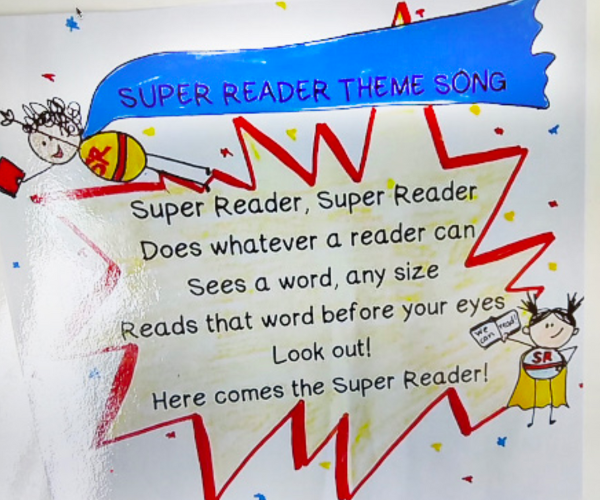
In teacher Katie Wears’ kindergarten classroom, students have to earn their cape—literally. As a culminating activity for Bend 1 in the new Super Powers: Reading with Phonics and Sight Word Power unit, students get to make their own costumes after they have mastered the skill of “slider power” when reading new words. All lightning bolts, green rings, golden lassos, and vibranium claws are welcome.  “I purchased a variety of very inexpensive colored capes online. Kids will get a piece of construction paper to decorate. I will laminate the construction paper and pin it to the back of their capes,” said Wears, who was happy to start the new unit with all of her students back in class last January. It has been “only since the Monday after Thanksgiving that my entire class was there, all because of COVID-19. It took weeks of catching up on required assessments and reestablishing routines and a sense of community.”
“I purchased a variety of very inexpensive colored capes online. Kids will get a piece of construction paper to decorate. I will laminate the construction paper and pin it to the back of their capes,” said Wears, who was happy to start the new unit with all of her students back in class last January. It has been “only since the Monday after Thanksgiving that my entire class was there, all because of COVID-19. It took weeks of catching up on required assessments and reestablishing routines and a sense of community.”
The updated unit places kindergartners in a superhero-themed learning environment that makes them heroes-in-training. Guided by their mentor Mighty Reader—and their teacher, of course—students learn to exercise specific powers in the battle to decode words. They then embark on short missions to make those around them happy by sharing their new-found skill.
The new unit represents the first update to the Super Powers unit in more than five years and integrates new reading research on phonics and reading alongside a greater and more directed emphasis on diversity.
As an experienced Units of Study teacher who volunteered to pilot the new unit, Wears noticed some important, strategic shifts. She said the inclusion of new reading research is readily apparent, alongside significant adjustments in the reading material used and available to students.
A veteran teacher, Wears works at Heathcote Elementary School in Scarsdale, New York, a high-performing school district outside New York City. The school has a well-established commitment to the reading and writing workshop and Units of Study (UoS), and currently has a TCRWP staff developer who visits to support the work.
In her classroom, Wears said her students this year are “highly energetic.” Teaching the new reading unit—and teaching in general—has posed unique challenges given disruptions to pre-K learning and opportunities during the pandemic.
“Their pre-school experience was interrupted by COVID-19. Some students had virtual pre-school and some didn’t,” said Wears. “They need additional support with so many things. One example is fine motor skills. I try to provide additional opportunities across the day for students to practice those skills.”
The following are day-by-day reflections from Wears’ first week piloting Bend 1 of the Super Powers unit. These observations were pulled from her daily Twitter posts to parents as well as from her responses to some specific questions from Heinemann.
In teacher Katie Wears’ kindergarten classroom, students have to earn their cape—literally. As a culminating activity for Bend 1 in the new Super Powers: Reading with Phonics and Sight Word Power unit, students get to make their own costumes after they have mastered the skill of “slider power” when reading new words. All lightning bolts, green rings, golden lassos, and vibranium claws are welcome.  “I purchased a variety of very inexpensive colored capes online. Kids will get a piece of construction paper to decorate. I will laminate the construction paper and pin it to the back of their capes,” said Wears, who was happy to start the new unit with all of her students back in class last January. It has been “only since the Monday after Thanksgiving that my entire class was there, all because of COVID-19. It took weeks of catching up on required assessments and reestablishing routines and a sense of community.”
“I purchased a variety of very inexpensive colored capes online. Kids will get a piece of construction paper to decorate. I will laminate the construction paper and pin it to the back of their capes,” said Wears, who was happy to start the new unit with all of her students back in class last January. It has been “only since the Monday after Thanksgiving that my entire class was there, all because of COVID-19. It took weeks of catching up on required assessments and reestablishing routines and a sense of community.”
The updated unit places kindergartners in a superhero-themed learning environment that makes them heroes-in-training. Guided by their mentor Mighty Reader—and their teacher, of course—students learn to exercise specific powers in the battle to decode words. They then embark on short missions to make those around them happy by sharing their new-found skill.
The new unit represents the first update to the Super Powers unit in more than five years and integrates new reading research on phonics and reading alongside a greater and more directed emphasis on diversity.
As an experienced Units of Study teacher who volunteered to pilot the new unit, Wears noticed some important, strategic shifts. She said the inclusion of new reading research is readily apparent, alongside significant adjustments in the reading material used and available to students.
A veteran teacher, Wears works at Heathcote Elementary School in Scarsdale, New York, a high-performing school district outside New York City. The school has a well-established commitment to the reading and writing workshop and Units of Study (UoS), and currently has a TCRWP staff developer who visits to support the work.
In her classroom, Wears said her students this year are “highly energetic.” Teaching the new reading unit—and teaching in general—has posed unique challenges given disruptions to pre-K learning and opportunities during the pandemic.
“Their pre-school experience was interrupted by COVID-19. Some students had virtual pre-school and some didn’t,” said Wears. “They need additional support with so many things. One example is fine motor skills. I try to provide additional opportunities across the day for students to practice those skills.”
The following are day-by-day reflections from Wears’ first week piloting Bend 1 of the Super Powers unit. These observations were pulled from her daily Twitter posts to parents as well as from her responses to some specific questions from Heinemann.
Super Powers: Reading with Phonics and Sight Word Power BEND 1 Week 1
| DAY 1 Readers Have Super Powers to Look, Point, and Read |
Q What are your expectations for the first bend of the new unit?
A “The original Super Powers unit was incredibly engaging. Even though I am teaching the new version of the unit, I am looking forward to high levels of engagement . . . I hope to help learners transfer everything we have been working on to support phonological awareness and phonics development to print and decoding words."
| DAY 2 Super Readers Decide Which Power to Use |
Q What surprises have come up in the first few days—those that delighted you and those that forced a course correction for your unit plan?
A “Introducing ‘Mighty Reader’ and the tools has been incredibly engaging . . . The amount of information and resources is incredible. It will be important for school districts to plan for meaningful time to digest the information.” In a follow-up interview, Wears said, “Session 1 is a lot of prep. You need to be proactive to learn the content.”
In a follow-up interview, Wears said, “Session 1 is a lot of prep. You need to be proactive to learn the content.”
Wears said she is thinking about how best to organize and incorporate decodable texts in the classroom library, and the need to refresh partner and table bins. She also noted the number of supplies needed for the unit, including small arrow-shaped stickers to support kids as they practice “slider power,” and materials for 3 envelopes and 2 baggies. She also was thinking more about the best way to make the capes for the end of the first bend of the unit.
“No one can teach this unit without the decodable texts,” Wears added. Downloading paper books off the Heinemann online resources and assembling and stapling books has taken time, but has been an enormous help.
| DAY 3 Super Readers Look through Words from Beginning to End |

Katie’s Reflection: “Tip that was successful: Yesterday I practiced today’s minilesson with a small group. I also ordered decodable readers to support the shifts in the unit.”
| DAY 4 Readers Think While They Read |
Katie’s Reflection: “Kiddos did a great job with slider power and decoding CVC words. They were all so excited and proud. The new power feels like it supports a variety of learners. Slider power was not in the original unit. The incorporation of decodable texts is providing more practice transferring phonological and phonics skills.”
| DAY 5 Super Readers Fix It! DAY 6 Super Readers Team Up to Give Reminders and Use Powers Together |
 Q How have the students responded to the revised unit in ways that are different from the previous one?
Q How have the students responded to the revised unit in ways that are different from the previous one?
A “It really forces kids to slow down and decode the words, which is a higher cognitive demand. In some ways they need less reading material because they are going slower.”
In the previous version of this unit there were more pattern books and leveled texts that students could run through quickly. The general rule was 10–14 of these type books per week. In order to read, students relied on memorizing patterns and used the pictures alongside decoding strategies.
The new unit forces students to slow down. When they come across a word like ”kit,” they need to work at it: k-i-t.



